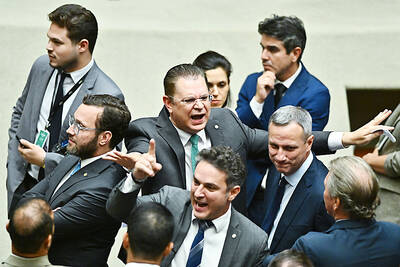British scientists are set to go where only Bruce Willis has gone before: chasing after asteroids on a collision course with Earth.
In a three-year ?300,000 (US$529,600) study funded by the UK government-backed Engineering and Physical Sciences Research Council, engineers will use computer simulations to work out the feasibility of changing the direction of asteroids.
"It's clear from geological records that the Earth has been impacted in the past by large objects," Colin McInnes of Strathclyde University said. Although none of the space objects currently tracked by NASA are heading for Earth, McInnes added that preparing for a potential catastrophe was a valid concern.
"You have to place it in context -- it's a small risk but with a high consequence," he said.
The project will look at a range of methods proposed by scientists over the years, from giant mirrors floating in space which could vaporize parts of an asteroid to methods that rely more on brute force, such as smashing a rocket into the asteroid to deflect it.
"The deflection methods fall mainly in two categories, kinetic methods and low-thrust methods," Gianmarco Radice of Glasgow University said.
"Kinetic methods are those which provide an instantaneous change of properties within the asteroid.
Sending a nuclear warhead or some sort of exploding device against the asteroid ... to create shock wave, for example. Low-thrust methods range from painting the surface of the asteroid with reflective or absorbing paint so that the properties of the surface are changed by attracting more or less light, thus heating or cooling the surface and changing the physical properties of the asteroid," Radice said.
Whatever method is used, it would only change the path of the asteroid by minute amounts.
"You can make very small adjustments to their orbits to create large changes in their orbits in the future," McInnes said.
The exact methods used would have to vary depending on the type of asteroid being targeted.

PARLIAMENT CHAOS: Police forcibly removed Brazilian Deputy Glauber Braga after he called the legislation part of a ‘coup offensive’ and occupied the speaker’s chair Brazil’s lower house of Congress early yesterday approved a bill that could slash former Brazilian president Jair Bolsonaro’s prison sentence for plotting a coup, after efforts by a lawmaker to disrupt the proceedings sparked chaos in parliament. Bolsonaro has been serving a 27-year term since last month after his conviction for a scheme to stop Brazilian President Luiz Inacio Lula da Silva from taking office after the 2022 election. Lawmakers had been discussing a bill that would significantly reduce sentences for several crimes, including attempting a coup d’etat — opening up the prospect that Bolsonaro, 70, could have his sentence cut to

A plan by Switzerland’s right-wing People’s Party to cap the population at 10 million has the backing of almost half the country, according to a poll before an expected vote next year. The party, which has long campaigned against immigration, argues that too-fast population growth is overwhelming housing, transport and public services. The level of support comes despite the government urging voters to reject it, warning that strict curbs would damage the economy and prosperity, as Swiss companies depend on foreign workers. The poll by newspaper group Tamedia/20 Minuten and released yesterday showed that 48 percent of the population plan to vote

A powerful magnitude 7.6 earthquake shook Japan’s northeast region late on Monday, prompting tsunami warnings and orders for residents to evacuate. A tsunami as high as three metres (10 feet) could hit Japan’s northeastern coast after an earthquake with an estimated magnitude of 7.6 occurred offshore at 11:15 p.m. (1415 GMT), the Japan Meteorological Agency (JMA) said. Tsunami warnings were issued for the prefectures of Hokkaido, Aomori and Iwate, and a tsunami of 40cm had been observed at Aomori’s Mutsu Ogawara and Hokkaido’s Urakawa ports before midnight, JMA said. The epicentre of the quake was 80 km (50 miles) off the coast of

RELAXED: After talks on Ukraine and trade, the French president met with students while his wife visited pandas, after the pair parted ways with their Chinese counterparts French President Emmanuel Macron concluded his fourth state visit to China yesterday in Chengdu, striking a more relaxed note after tough discussions on Ukraine and trade with Chinese President Xi Jinping (習近平) a day earlier. Far from the imposing Great Hall of the People in Beijing where the two leaders held talks, Xi and China’s first lady, Peng Liyuan (彭麗媛), showed Macron and his wife Brigitte around the centuries-old Dujiangyan Dam, a World Heritage Site set against the mountainous landscape of Sichuan Province. Macron was told through an interpreter about the ancient irrigation system, which dates back to the third century